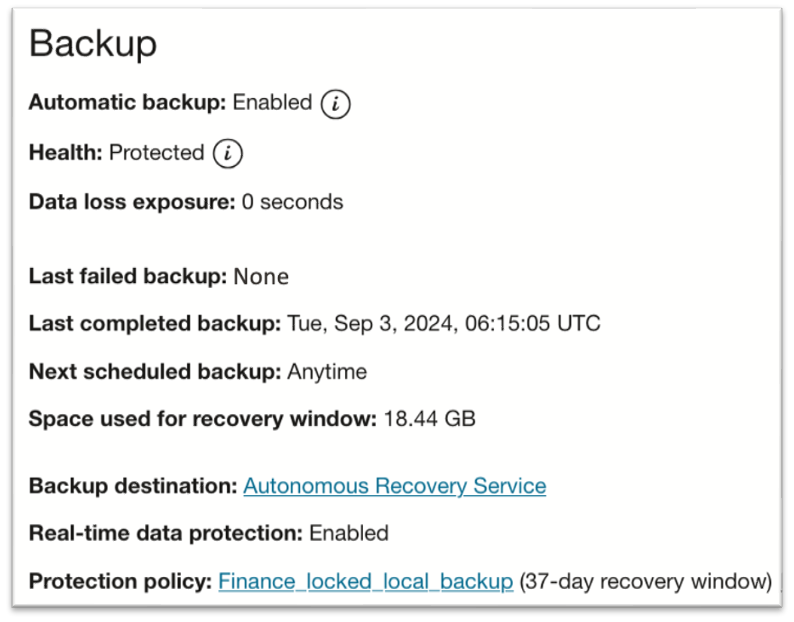Organizations are rightfully focused on reducing business risk due to the increasing threat of ransomware attack, data theft, and malicious data deletion or alteration. Oracle Database Zero Data Loss Autonomous Recovery Service, a fully managed service based on the on-premises Oracle’s Zero Data Loss Recovery Appliance technology, is now available for organizations running Oracle Exadata Database Service on Oracle Database@Azure. The Recovery Service helps organizations quickly recover business-critical data from ransomware attacks with zero data loss, help comply with financial requirements by improving operational efficiency, and meet user expectations for cloud service simplicity.
Key benefits of Recovery service
- Use Microsoft Azure Consumption Commitment (MACC) to pay for backup storage
- Choose the backup storage location to address any corporate data residency and compliance requirements
- Provides zero data loss with real-time database protection, which enables recovery to within less than a second of when an outage or ransomware attack occurred
- Backup immutability using a policy-based backup retention lock that prevents backup deletion or alteration by any user in the tenancy
- Helps prevent data theft with mandatory automatic encryption for all backup data throughout the entire lifecycle
- Achieve higher operational efficiency by eliminating the need for weekly full backups – this can reduce the CPU, memory, and I/O overhead when running backups, which can help lower overall database cloud costs
- Shorten the backup window with an incremental forever paradigm that moves smaller amounts of backup data between the database and the Recovery Service
- Improve recoverability with automated zero-impact recovery validation for all database backups
- Recover faster to any region with optimized backups, which eliminates the need to recover multiple incremental backups
- Centralized database protection insights with a granular recovery health dashboard
Architecture
The Recovery Service is available as a backup destination in Oracle Cloud Infrastructure (OCI) or Microsoft Azure, as shown in Figure 1. Recovery Service infrastructure is in an Oracle-managed tenancy, which is connected to the customer tenancy with private endpoints for Oracle Recovery Manager (RMAN) communication. For high availability within the region, Recovery Service automatically replicates backups to another availability zone (Azure) or availability domain (OCI). During restore, customers can leverage original or replicated backups. Recovery Service creates a virtual full backup (container database or individual pluggable database) to the point of of last incremental backup and sends the full along with archived log backups for fast, point-in-time recovery on any accessible Exadata Database Service in any Azure or OCI region. The Recovery Service protection policy (Figure 2) allows customers to specify Azure as the backup location by using the option to store backups in the same cloud as the database. The protection policy also allows custom retention options, including retention lock.


To get started, simply select the Autonomous Recovery Service as the Backup destination when configuring automatic backups for Oracle Database@Azure as shown in Figure 3 below. Choose the Protection policy that defines your retention and cloud destination.

Once enabled, Recovery Service capacity utilized for backups is simply billed to the MACC subscription for the Oracle Database@Azure being protected. This subscription and location information will appear on the protected database details page (Figure 4). The status of your backups is available on the Recovery Service protected database details page (Figure 4) and on the Oracle Database@Azure database details screen (Figure 5).


Availability
Oracle Database Zero Data Loss Autonomous Recovery Service is available as a backup destination in all Azure regions with Oracle Database@Azure.
Join us at Oracle CloudWorld to learn more about Recovery Service and this new integration. There will be a hands-on lab, a learning session and staff available in the exhibit space for questions.
- Tutorial: Protect and Recover Databases from Ransomware with Oracle Recovery Service [TUT2376]
- Learning Session: What’s New in Oracle’s Recovery Service and Database Backup and Recovery [LRN3023]
Additional Resources
- Introducing Zero Data Loss Recovery Capabilities with Oracle Exadata Database Service and Oracle Base Database Service
- Retention lock your cloud database backups for increased ransomware protection
- Zero Data Loss Autonomous Recovery Service Onboarding checklist
- Technical Documentation

